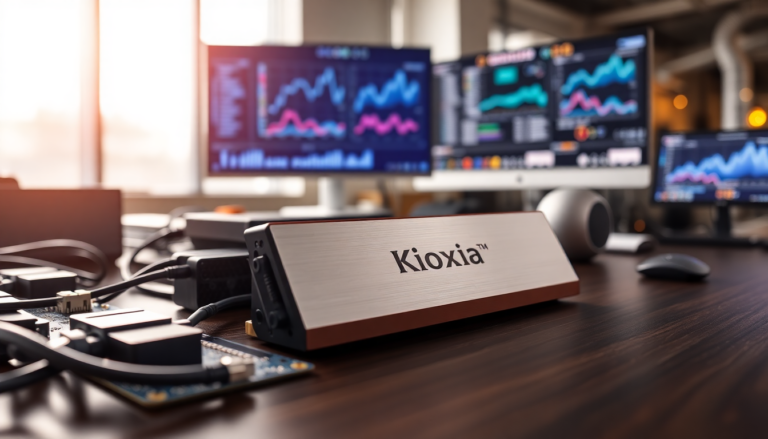Argomenti trattati
Kioxia has just taken a monumental step in the world of data storage with the introduction of a remarkable solid-state drive (SSD) that boasts an astonishing capacity of 245.76TB. This impressive innovation positions the LC9 SSD at the forefront of high-capacity storage solutions, particularly for demanding applications like artificial intelligence (AI) training and hyperscale computing tasks. As our need for effective data management and processing continues to soar, this development isn’t just a technological upgrade; it represents a crucial shift in how we store and access data in our ever-evolving digital environment.
Unpacking the LC9 SSD’s Specifications
The Kioxia LC9 SSD employs a proprietary NVMe 2.0-compliant controller and features a PCIe 5.0 x4 interface, which allows for dual-port capabilities, significantly boosting data transfer speeds and flexibility. At the heart of its impressive storage capacity is Kioxia’s groundbreaking BiCS8 2Tb 3D QLC NAND memory technology. By ingeniously stacking 32 individual memory devices into a single chip, each providing 8TB of storage space, Kioxia has set a new standard for density in SSD design.
To really grasp the enormity of this capacity, consider this: a single compressed 4K movie typically takes up about 20GB of storage. That means the LC9 could potentially hold around 12,500 movies—a jaw-dropping figure that highlights its capabilities. However, while the drive’s storage capacity is impressive, we also need to dive into its performance metrics to truly understand its overall utility.
Performance and Endurance Analysis
When it comes to performance, the LC9 SSD delivers sequential read speeds of up to 12 GB/s and write speeds of 3 GB/s. While these speeds might not compete with the fastest enterprise PCIe 5.0 SSDs available on the market, it’s important to note that Kioxia has prioritized capacity over sheer speed. This trade-off is common in high-density storage solutions, where maintaining signal integrity in a 32-layer 3D NAND setup often requires some compromises in interface speed.
Random read and write operations yield up to 1.3 million IOPS and 50,000 IOPS, respectively. While these figures may not be groundbreaking, they reflect the LC9’s design philosophy centered on capacity rather than high-performance metrics. Additionally, the endurance rating is set at 0.3 drive writes per day (DWPD), striking a balance between longevity and usability in data center environments.
Reliability Features and Future Prospects
The Kioxia LC9 SSD is equipped with several features designed to bolster reliability and data protection. These include die-level recovery mechanisms, parity-based error management, and safeguards against unexpected power loss. Plus, the drive supports Flexible Data Placement, a feature that reduces internal write amplification, thereby enhancing the device’s lifespan, especially in database-driven applications.
As data security continues to be a top priority, Kioxia addresses this concern with encryption and firmware signing that comply with CNSA 2.0 standards. The drive offers multiple encryption modes, including AES-256, and is prepared for future algorithms designed for post-quantum cryptography, ensuring robust data protection in an increasingly complex cybersecurity landscape.
Looking ahead, Kioxia plans to launch the LC9 series in various form factors, including 2.5-inch U.2 and E3.S configurations, targeting large hyperscale data center operators. While pricing details are still under wraps, these drives are expected to meet the specific needs of these enterprises, with costs varying based on volume and other factors. The LC9 series is currently being sampled to select partners and is set to capture attention at the upcoming Future of Memory and Storage conference in August 2025. Will this groundbreaking SSD redefine the future of data storage? Only time will tell.

